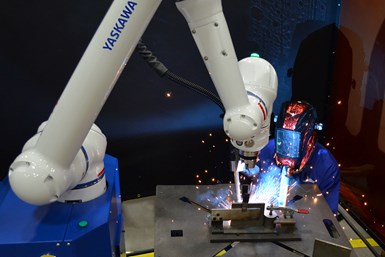Robot Series Facilitates Collaborative Welding
IMTS22: HC10 and HC20 human collaborative robots possess the ability to work with or in close proximity to human personnel. Both these robots are meant to supplement the spaces they inhabit, and they are able to readjust based on production needs.
Share




.png;maxWidth=45)
DMG MORI - Cincinnati
Featured Content
View More




Designed to add robotic welding capacity to current production, the Yaskawa America Inc., six-axis HC10 and HC20 human-collaborative robots enable operation with, or in close proximity to, human workers. Suited for supplementing manual welding or for rolling up to large, heavy workpieces with its 1,379 mm reach, the 10 kg payload HC10 can be adjusted depending on production needs. The HC20 model offers even greater reach at 1,900 mm and an increased payload of 20 kg.
Yaksawa says the highly repeatable HC10 or HC20 can easily shift between collaborative speed in PFL mode or full speed in industrial mode, optimizing cycle times based on risk assessment and process requirements. Robot path teaching can be accomplished by hand guiding, teach pendant or jogging with an external device using I/O control. Built with cast aluminum for industrial durability, the HC10 and HC20 feature a rugged IP67 rating to operate in harsh welding environments. To top it off, the robots have an easy to clean surface.
The HC-series robots meet established safety standards, including being TUV-certified to ISO 13849-1 and complying with ISO 10218-1 and ISO TS 15066. They feature Power and Force Limiting (PFL) where dual channel torque sensors in all joints constantly monitor force to quickly react. These robots also offer precision hand-guiding. The goal of this feature is to facilitate easy programming for fast implementation of a robot system.
Designed with the safety in mind, the pinch-less HC10 and HC20 has the potential to operate without additional protective measures, resulting in reduced cost and space requirements. However, this claim is risk assessment dependent and may vary from company to company. Through-arm utilities hide cabling, including a Category 6 ethernet cable enabling communications for a wide variety of tooling options. This reduces the risk of snagging or interference with other equipment.
Related Content
-
CNC Machine Shop Honored for Automation, Machine Monitoring
From cobots to machine monitoring, this Top Shop honoree shows that machining technology is about more than the machine tool.
-
Four-Axis Horizontal Machining Doubles Shop’s Productivity
Horizontal four-axis machining enabled McKenzie CNC to cut operations and cycle times for its high-mix, high-repeat work — more than doubling its throughput.
-
Managing Coolant with Skimmers, Refractometers and More
Bacteria-infected coolant harms machines and sickens machinists. Coolant management technologies like skimmers and automated systems counter this tendency.


































